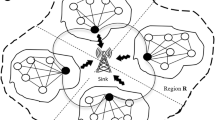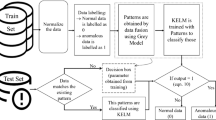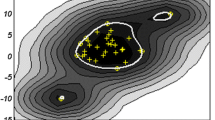Abstract
In order to improve the transmission stability of sensor networks, a sensitive data mining method based on Pan Boolean algebra is proposed. According to the output correctness, reliability and operation efficiency of wireless sensor network, this paper analyzes the characteristics of sensitive data, extracts and clusters the associated features of sensitive data, establishes the information clustering model of sensitive data in sensor network, and detects the fuzzy factor of sensitive data in sensor network with grid block clustering method, The Pan Boolean algebra analysis model is used to realize the hybrid deep learning of sensor network sensitive data detection and realize the optimization of sensor network sensitive data mining. The simulation results show that this method has high precision in mining sensitive data of WSN, and improves the reliability of WSN.




Similar content being viewed by others
Code availability
Not applicable.
Availability of data and material
The datasets used and/or analyzed during the current study are available from the corresponding author on reasonable request.
References
Fakhar, M., Mahyarinia, M. R., & Zafarani, J. (2018). On nonsmooth robust multiobjective optimization under generalized convexity with applications to portfolio optimization. European Journal of Operational Research, 265(1), 39–48.
Sun, X. K., Li, X. B., Long, X. J., et al. (2017). On robust approximate optimal solutions for uncertain convex optimization and applications to multi-objective optimization. Pacific Journal of Optimization, 13(4), 621–643.
Han, J. H., Yuan, J. X., Wei, X., & Lu, Y. (2019). Pedestrian visual positioning algorithm for underground roadway based on deep learning. Journal of Computer Applications, 39(3), 688–694.
Yu, Z., Li, L., Liu, J., et al. (2015). Adaptive noise immune cluster ensemble using affinity propagation. IEEE Transactions on Knowledge and Data Engineering, 27(12), 3176–3189.
Huang, D., Lai, J., & Wang, C. (2015). Combining multiple clusterings via crowd agreement estimation and multi-granularity link analysis. Neurocomputing, 170, 240–250.
Yang, Y. (2008). Elements of information theory. Journal of the American Statistical Association, 103(3), 429–429.
Iam-On, N., Boongoen, T., Garrett, S., et al. (2011). A link-based approach to the cluster ensemble problem. IEEE Transactions on Pattern Analysis and Machine Intelligence, 33(12), 2396–2409.
Xu, J., Miao, D., Zhang, Y., et al. (2017). A three-way decisions model with probabilistic rough sets for stream computing. International Journal of Approximate Reasoning, 88, 1–22.
Miao, D. Q., Xu, F. F., Yao, Y. Y., et al. (2012). Set-theoretic formulation of granular computing. Chinese Journal of Computers, 35(2), 351–363.
Abualigah, L. M., Khader, A. T., Al-Betar, M. A., et al. (2017). Text feature selection with a robust weight scheme and dynamic dimension reduction to text document clustering. Expert Systems with Applications, 84(C), 24–36.
Huang, D., Wang, C., & Lai, J. (2016). Locally weighted ensemble clustering. IEEE Transactions on Cybernetics, 48(5), 1460–1473.
Al-Hussein, A., & Haldar, A. (2015). Unscented Kalman filter with unknown input and weighted global iteration for health assessment of large structural systems. Structural Control and Health Monitoring, 23(1), 156–175.
Liu, Y. L., Liu, J., & Liu, J. N. (2013). Research on composite inversion of dynamic loads and structural parameters based on sub-structure analysis. Journal of Mechanical Strength, 35(5), 553–558.
Arbabi, A., Horie, Y., Ball, A. J., et al. (2015). Subwavelength-thick lenses with high numerical apertures and large efficiency based on high-contrast transmitarrays. Nature Communications, 6(5), 69–74.
Cao, B., Zhao, J., Gu, Y., Ling, Y., & Ma, X. (2020). Applying graph-based differential grouping for multiobjective large-scale optimization. Swarm Evolution Computer, 53, 100626.
Li, T., Xu, M., Zhu, C., Yang, R., Wang, Z., & Guan, Z. (2019). A deep learning approach for multi-frame in-loop filter of HEVC. IEEE Transactions Image Processing, 28(11), 5663–5678.
Liu, J., Wu, C., Wu, G., & Wang, X. (2015). A novel differential search algorithm and applications for structure design. Applied Mathematics and Computation, 268, 246–269.
Arbabi, E., Arbabi, A., Kamali, S. M., et al. (2016). Multiwavelength polarization-insensitive lenses based on dielectric metasurfaces with meta-molecules. Optica, 3(6), 628–633.
Lv, Z., & Kumar, N. (2020). Software defined solutions for sensors in 6G/IoE. Computer Communications, 153, 42–47.
Lv, Z., & Song, H. (2020). Mobile internet of things under data physical fusion technology. IEEE Internet of Things, 7(5), 4616–4624.
Han, J. L. (2018). Research on interest classification of online shopping users based on data mining. Computer Simulation, 35(7), 23–29.
Gao, W., & Wang, W. F. (2017). The fifth geometric-arithmetic index of bridge graph and carbon nanocones. Journal of Difference Equations and Applications, 23(1-2SI), 100–109.
Ni, T., Chang, H., Song, T., Xu, Q., Huang, Z., Liang, H., Yan, A., & Wen, X. (2019). Non-intrusive online distributed pulse shrinking based interconnect testing in 2.5 DIC. IEEE Transactions on Circuits and Systems II: Express Briefs, 1.
Melicherová, M., Ondrišová, M., & Šušol, J. (2021). Bibliometrics versus altmetrics: Researchers’ attitudes in Slovakia. Iberoamerican Journal of Science Measurement and Communication, 1(1), 002.
Yang, W., Zhao, Y., Wang, D., Wu, H., Lin, A., & He, L. (2020). Using principal components analysis and IDW interpolation to determine spatial and temporal changes of surface water quality of Xin’ anjiang River in Huangshan, China. International Journal of Environmental Research and Public Health, 17(8), 2942.
Gao, W., et al. (2017). Ontology learning algorithm for similarity measuring and ontology mapping using linear programming. Journal of Intelligent & Fuzzy Systems, 33(5), 3153–3163.
Qureshi, S., & Atangana, A. (2019). Mathematical analysis of dengue fever outbreak by novel fractional operators with field data. Physica A-Statistical Mechanics and Its Applications, 526, 121127.
Zhu, J., Shi, Q., Wu, P., Sheng, Z., & Wang X. (2018). Complexity analysis of prefabrication contractors, dynamic price competition in mega projects with different competition strategies. Complexity, 1–9.
Zhu, J., Wu, P., Chen, M., Kim, M. J., Wang, X., & Fang, T. (2020). Automatically processing IFC clipping representation for BIM and GIS integration at the process level. Applied Sciences, 10(6), 2009.
Zuo, C., Li, J., Sun, J., Fan, Y., Zhang, J., Lu, L., Zhang, R., Wang, B., Huang, L., & Chen, Q. (2020). Transport of intensity equation: A tutorial. Optics and Lasers in Engineering, 135, 106187.
Funding
Not applicable.
Author information
Authors and Affiliations
Corresponding author
Ethics declarations
Conflicts of interest
No conflict of interest exits in the submission of this manuscript.
Additional information
Publisher's Note
Springer Nature remains neutral with regard to jurisdictional claims in published maps and institutional affiliations.
Rights and permissions
About this article
Cite this article
Lin, R., He, Y. & Xu, M. Method of sensitive data mining based on Pan-Bull algebra. Wireless Netw 28, 2733–2741 (2022). https://doi.org/10.1007/s11276-021-02725-9
Accepted:
Published:
Issue Date:
DOI: https://doi.org/10.1007/s11276-021-02725-9




